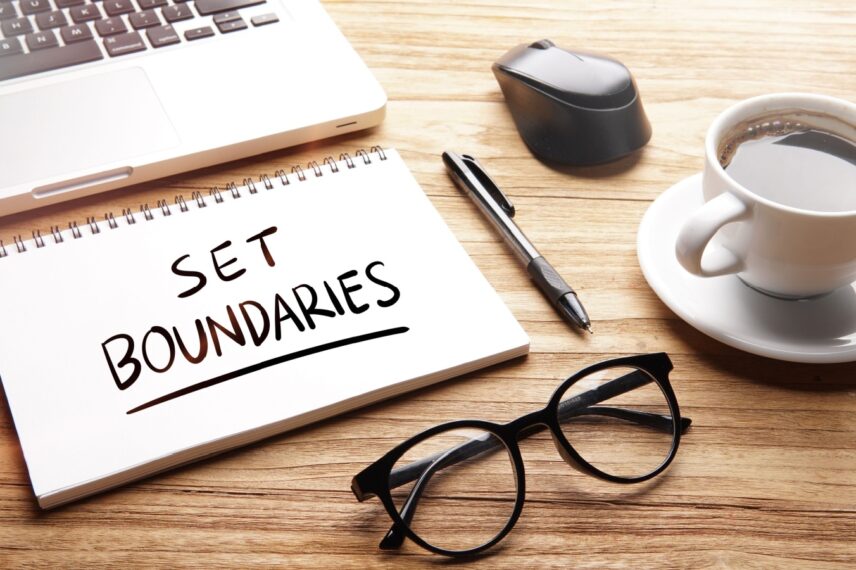Photo Credit: Shutterstock.
Many of us struggle with setting boundaries and saying no, often feeling overwhelmed and unable to prioritize our own needs. Learning to assert boundaries is imperative for our well-being and personal growth. By mastering the art of saying no with confidence, we can take control of our lives and establish healthier relationships.
The Basics of Boundaries
Setting boundaries is an vital part of maintaining healthy relationships and preserving your well-being. It involves knowing your limits and being able to communicate them effectively to others. Without boundaries, you may feel overwhelmed, taken advantage of, or emotionally drained. Learning to establish and uphold boundaries is a crucial skill for personal growth and self-care.
Defining Personal Boundaries
Personal boundaries are the physical, emotional, and mental limits we set to protect ourselves from being manipulated, used, or violated by others. These boundaries define who we are and what we stand for, helping us to maintain a sense of individuality and self-respect. They are guidelines for acceptable behavior and interactions, both in our personal and professional lives.
Understanding your personal boundaries involves recognizing your values, beliefs, and needs, as well as understanding how you want to be treated by others. It requires self-awareness and the ability to assert yourself confidently in various situations. By defining and communicating your boundaries clearly, you can cultivate healthier relationships built on mutual respect and understanding.
Types of Boundaries: Physical, Emotional, and More
Types of boundaries can be categorized into different areas such as physical, emotional, material, and time boundaries. These boundaries help us navigate our relationships and interactions with others, ensuring that we feel safe, respected, and valued. Recognizing and setting these boundaries is vital for maintaining a healthy balance in our lives.
- Physical Boundaries
- Emotional Boundaries
- Material Boundaries
- Time Boundaries
- Intellectual Boundaries
Establishing physical boundaries involves setting limits on touch, personal space, and physical interactions with others. It includes recognizing when you feel uncomfortable or unsafe in a physical context and being able to communicate your needs effectively. By respecting your physical boundaries, you can ensure your physical well-being and maintain a sense of agency over your body.
| Types | Physical Boundaries |
| Definition | Setting limits on touch, personal space, and physical interactions with others. |
| Examples | Not wanting to be hugged without consent, setting boundaries on physical intimacy in relationships. |
| Importance | Respecting physical boundaries is crucial for personal safety and well-being. |
| Tips | Communicate your boundaries clearly, be assertive in expressing your needs, seek support if your boundaries are violated. |
The Psychology Behind Difficulties with Boundaries
Pleasing Others: Why We Struggle to Say No
Little by little, we may find ourselves giving in to others’ requests, even at the cost of our own time and well-being. The desire to please others and the fear of disappointing them can often lead us to say yes when we really want to say no. This struggle to set boundaries stems from a deep-seated need for approval and acceptance.
Boundaries are imperative for maintaining healthy relationships and self-respect. When we constantly prioritize others’ needs over our own, we risk diminishing our sense of self-worth and agency. Learning to say no with confidence is a crucial step in reclaiming our autonomy and emotional well-being.
Fear of Rejection and Its Impact
Difficulties with setting boundaries can also be linked to a fear of rejection. The thought of saying no and risking disapproval or conflict can trigger anxiety and discomfort. This fear can be deeply rooted in past experiences or internalized beliefs about not being worthy of respect or consideration.
Fear of Rejection and Its Impact
With practice and self-awareness, we can gradually overcome this fear and develop healthier boundaries. Setting limits and communicating our needs assertively can lead to more authentic and fulfilling relationships based on mutual respect and understanding. Do not forget, it’s okay to prioritize your own well-being and say no when necessary.
Techniques for Establishing Your Boundaries
Despite the challenges that may come with setting boundaries, mastering the art of saying no is crucial for your well-being and mental health. By establishing clear boundaries, you communicate your needs and limits to others, creating a healthier relationship with yourself and those around you.
Self-Reflection and Recognizing Your Limits
With self-reflection, you can gain a deeper understanding of your values, priorities, and limits. Take time to assess what is important to you and where you draw the line. Recognizing your limits allows you to set boundaries that align with your needs and values, empowering you to say no confidently when necessary.
By understanding your capabilities and acknowledging your boundaries, you develop a sense of self-awareness that is crucial for establishing and maintaining healthy boundaries. It is okay to prioritize your well-being and set limits to protect your mental and emotional health.
Communicating Your Boundaries Effectively
The key to communicating your boundaries effectively is clarity and assertiveness. Clearly express your needs and limits to others in a calm and respectful manner. Use “I” statements to own your boundaries without blaming or accusing others.
When setting boundaries, it is important to be consistent and firm in your communication. Be prepared to reinforce your boundaries if they are tested or crossed. Remember that establishing boundaries is an ongoing process, and it is okay to reassess and adjust them as needed.
Communicating your boundaries effectively can strengthen your relationships and foster mutual respect. By clearly expressing your needs, you create a healthy dynamic that benefits both you and those around you.
Common Scenarios Where Boundaries Matter
To truly master boundaries, it’s imperative to recognize the different scenarios where setting limits is crucial. By understanding these common situations, you can navigate them with confidence and assertiveness.
In the Workspace: Setting Professional Limits
An important aspect of mastering boundaries is knowing when and how to set limits in the workplace. Whether it’s saying no to additional tasks outside your job scope or establishing clear communication channels with colleagues, setting professional boundaries is key to maintaining a healthy work environment.
Keep in mind, it’s okay to prioritize your workload and well-being. By setting boundaries around your time, tasks, and interactions, you can foster respect and professionalism in your professional relationships.
At Home: Respecting Personal Space and Time
Time spent at home is precious, and it’s imperative to establish boundaries to ensure a healthy work-life balance. This includes setting limits on work-related activities during personal time, as well as communicating your needs with family members or housemates.
The key to maintaining boundaries at home is open and honest communication. By expressing your needs and expectations clearly, you can create a harmonious and respectful living environment for everyone.
Practicing Saying No
Not being able to say no can leave you overwhelmed and overcommitted. Mastering the art of saying no with confidence is a valuable skill that can greatly improve your well-being and quality of life.
Role-Playing and Other Strategies
With role-playing, you can practice saying no in a safe environment with a friend or coach. This allows you to build your confidence and find ways to assert your boundaries effectively. Visualization techniques and affirmations can also help strengthen your ability to say no when needed.
Another helpful strategy is setting clear boundaries and priorities in advance. By knowing your limits and values, you can make saying no easier and more authentic. Do not forget, saying no is not a rejection of the person making the request, but a way to honor yourself and your needs.
Keeping Your Cool: Handling Pushback Gracefully
Pushback is a common response when you start setting boundaries and saying no. It’s important to remain calm and composed in these situations. By staying firm yet respectful, you can navigate pushback without compromising your boundaries or damaging relationships.
Handling pushback gracefully involves active listening, acknowledging the other person’s perspective, and standing firm in your decision. Do not forget, you have the right to say no without having to justify or defend your choice. By responding with confidence and empathy, you can assert your boundaries while maintaining respect and understanding.
Maintaining Boundaries Long-Term
Unlike short-term fixes, mastering boundaries involves a commitment to consistent self-awareness and adjustment. It’s imperative to understand that boundaries are not static and may need to evolve over time to meet your changing needs and circumstances. Here are some key strategies for maintaining boundaries in the long run.
Monitoring and Adjusting Your Boundaries
The key to maintaining boundaries long-term is monitoring how well they’re working for you. Regularly check in with yourself to assess whether your boundaries are still serving their intended purpose or if adjustments are needed. Reflect on how you feel about the boundaries you’ve set – are you feeling overwhelmed, resentful, or taken advantage of? If so, it may be time to reassess and make changes.
Dealing with Boundary Violations
with consistent practice, you’ll become more adept at handling boundary violations with confidence and assertiveness. When someone crosses a boundary you’ve set, it’s imperative to address the issue promptly and directly. Clearly communicate your boundaries and the impact of the violation on you. Bear in mind, it’s okay to reinforce your boundaries or even modify them if necessary to protect your well-being in the long run.
Long-term success in maintaining boundaries hinges on your ability to navigate both subtle and overt boundary violations effectively. By staying attuned to your needs and being proactive in addressing boundary issues, you’ll cultivate healthier relationships and greater self-respect over time.
Conclusion
From above, it is clear that mastering boundaries and learning to say no with confidence is an imperative skill in maintaining healthy relationships and protecting your well-being. By setting clear boundaries and asserting yourself politely yet firmly, you can avoid overcommitting yourself and prevent feelings of resentment or burnout. Remember that saying no is not selfish; it is an act of self-care that allows you to prioritize your needs and protect your time and energy.
Practice setting boundaries in different aspects of your life, and gradually you will become more comfortable and confident in saying no when necessary. By mastering boundaries, you can create a balanced and fulfilling life where you can give generously to others without sacrificing your own well-being. Take the time to reflect on your boundaries and communication style, and remember that it is okay to say no with confidence.









